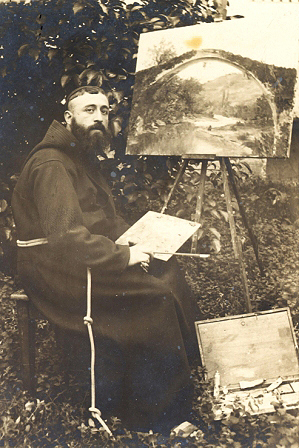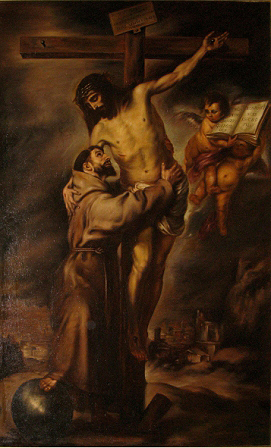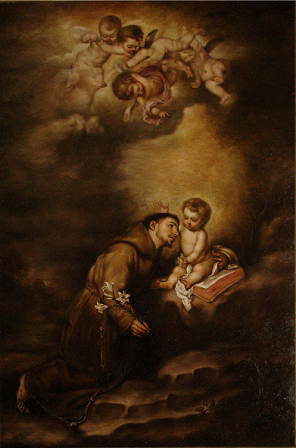The piece of the month of June 2014
SAINT FRANCISCO EMBRACING CHRIST AND SAINT ANTONIO DE PADUA WITH THE CHILD, WORKS BY FRAY PEDRO DE MADRID
José Javier Azanza López
Chair de Patrimonio y Arte Navarro
The church of San Antonio de Capuchinos in Pamplona houses a group of works of B artistic B from the high school of Lekaroz, where they arrived at the end of the 19th century as a deposit from the Royal Academy of Fine Arts of San Fernando, as Dr. García Gainza has studied. And, together with the previous ones, two good copies of the Sevillian painter Bartolomé Esteban Murillo (1617-1682), carried out a couple of decades later by the Capuchin Fr. Pedro de Madrid, also hang on the walls of the temple in Pamplona.
Pedro de Madrid (Madrid, 1880-1936), in the century Pedro Satué Blanco, entered the seminarhigh school of Lekaroz in 1893, where he was ordained priest on February 25, 1906. From the beginning, his artistic aptitudes did not go unnoticed by those in charge of the high school, especially when in Lekaroz the qualification of its friars in those subjects in which they excelled was carefully taken care of. Among them was music, given that, in addition to having the ability to sing, he played the double bass and the cello, both with orchestra and as a soloist, accompanying very frequently the solemn religious functions, as well as the literary and musical evenings in which he participated as an instrumentalist and zarzuela singer.
Antonio de Antequera, pioneer and manager of the photographic laboratory of Lekaroz. Although most of his photographs are testimonies of people and events, in a promotional as well as testimonial work of the daily life of the high school, the more artistic than documentary mood of Fr. Pedro will lead him to broaden his horizon and, influenced by the photographic pictorialism, to create narrative compositions with his own aesthetic existence. Explicit of this is his collection of twenty-four photographs of farmhouses in Baztan with which he won the Photographic-Social competition organized in Pamplona in July 1912, in the framework the VI Social Week and the commemorative acts of the VII Centenary of the battle of Navas de Tolosa.
Pedro de Madrid had his first contacts with Fr. Antonio de Vera, manager of the sculpture workshop, and probably with the Aragonese painter Ramiro Ros Ráfales, who between 1896 and 1898 spent several seasons in Lekaroz carrying out various commissions. Following the policy of continuous training characteristic of the center, he will carry out successive stays outside Lekaroz with the goal of improving his pictorial capacity and of making copies for the high school; San Sebastian, Madrid, Cordoba and Seville will be his destinations, in a chronological period between 1904 and 1918.
Within his pictorial production, the portrait was one of the occupations of Fr. Pedro de Madrid to satisfy the demand of the high school, carrying out, among others, those of Pope Pius X, of Fr. General of the Capuchins Fr. Bernardo de Andermatt, and Fr. The compositional rigidity that characterizes his portraits, generally made from a photograph, is tempered by the employment a loose and fluid brushstroke in the elaboration of some details of the clothing.
He also showed interest in landscape painting, a genre he worked in the open air, capturing the natural scenery of Baztania on his canvases. This is attested by a photograph in which he appears in front of the easel in the middle of nature, palette and brush in hand, with the tubes visible in the open box at his feet; seated with his face turned towards the spectator, he depicts the medieval bridge of Reparacea in Oieregi, in the immediate Bertizarana Valley, a motif that attracted the interest of other contemporary landscape painters such as Jesús Basiano.

Fray Pedro de Madrid painting the bridge of Reparacea, ca. 1910.
But the greater part of his pictorial production is made up of copies destined for the dependencies of the high school of Lekaroz; the personality of Fr. Pedro as a copyist is not at all negligible, at a time in which this profession begins to deserve the recognition of diverse social sectors. Testimony of the same is the written request that he addresses to the director the Prado Museum, the Sevillian painter José Villegas Cordero, on January 14, 1913, requesting permission to "make programs of study the works of art that encloses the Museum of his worthy direction". In his approach to the great masters of the Spanish Golden Age, the Capuchin reveals himself as an excellent interpreter of Murillo's painting -Fr. Zudaire describes him as a "skillful copyist of Murillo's paintings"-, from which he translates with virtuosity his vaporous style, the brushstroke of undone invoice and the vibrant handling of light.
At the end of 1915, Fr. Pedro de Madrid was sent to Andalusia "with the purpose of copying for this high school some paintings of famous painters", according to the President Fr. In 1916 he lived in Cordoba, busy copying paintings from the Museum of Fine Arts. The following year he moved to Seville, where he remained until the summer of 1918, copying various works painted by Murillo between 1665 and 1669 for the church of the disentailed Convent of Capuchinos in the capital of Seville, deposited in its Museum of Fine Arts. Among these were St. Francis embracing Christ ( 292 x ) and St. Anthony of Padua with Child (283 x ), which the Andalusian painter had executed for their respective altarpieces located on the Gospel wall of the Capuchin temple.
The episode of St. Francis embracing Christ does not appear in the official biographies of St. Francis, although there is a textual reference to it in the Legend of Blessed Christina of Saint-Truiden, a Flemish Beguine who died in 1224, and it also appears in Flemish devotional prints. It is a significant topic in Franciscan iconography, as it combines the vision of the founder of the order with the deep devotion to Christ crucified that the Capuchins professed. Pedro de Madrid faithfully follows the original composition, which sample the Crucified One unhooking his right arm from the cross to take the Franciscan saint under his lap, who, standing and with his face invaded by mysticism, also embraces the Redeemer. The embrace of the Crucified One is an expression of the divine reward for the saint's Withdrawal from earthly goods to serve only God and his neighbor, a decision that is made explicit in a very graphic way in the gesture of St. Francis stepping on the globe, as well as in the text that appears on the book held by two child angels, alluding to the Gospel passage of Luke 14:33: Qui non renuntiat omnibus, quae possidet, non potest meus esse discipulus (Whoever does not Withdrawal to all that he possesses, cannot be my disciple). It is the plastic expression of the Franciscan way of life, expressed with deep spiritual intimacy. The luminous intensity contributes to highlight the monumental figures of the Crucified and St. Francis, which are outlined against a barely sketched urban landscape.

Friar Pedro de Madrid, St. Francis Embracing Christ, 1917-1918
Pedro de Madrid that the church of Pamplona holds is Saint Anthony of Padua with the Child, topic iconographic copy of deep popular devotion based on an episode of the life of the saint collected in the Liber Miraculorum. In the middle of a landscape the saint is present with a foreshortened youthful face, kneeling before the Child as a sign of devotion and with his body slightly inclined forward; he wears a Franciscan habit and carries in his right hand the bouquet of lilies as a symbol of his virginity, while with his left hand he embraces the Child, seated on the book of the Sacred Scripture that acts as a pedestal. In the upper space we appreciate a break of glory with a group of angels contemplating the transcendental embrace, from which descends a cascade of golden light that serves as a background to the figure of the Child, thus standing out from the gloom of the rest of the canvas, dominated by an affective atmosphere thanks to the faces and gestures of both characters.
Through both works, which currently hang in the church of San Antonio de Padres Capuchinos in Pamplona after the closure of high school of Lekaroz, we can appreciate the ability of Fr. Pedro de Madrid as an interpreter, two and a half centuries later, of Murillo's painting, also evident in other copies made by the Capuchin, such as a second version of Saint Anthony of Padua with the Child, the Virgin of the napkin, Saint Thomas of Villanueva Child distributing his clothes, The children of the shell, an Immaculate Conception (in the same church of the Capuchins) and a Saint John the Baptist.

Fray Pedro de Madrid, St. Anthony of Padua with Child, 1917-1918
bibliography
-ANGULO IÑIGUEZ, D., Murillo, Madrid, Espasa-Calpe, 1981.
-AZANZA LÓPEZ, J. J., La report de la report, 1212-1912. Tras las huellas artísticas del VII Centenario de las Navas de Tolosa, Pamplona, 2012.
-AZANZA LÓPEZ, J. J. and SAN MARTÍN CASI, R., "Casa, familia, heredad. La colección fotográfica de caseríos vascos de Fr. Pedro de Madrid, 1912", Revista de Dialectología y Tradiciones Populares, vol. LXVIII, nº 2, July-December 2013, pp. 385-422.
-AZCONA, T. de "La fotografía en el high school de Lecároz (Baztán)", Fotografía en Navarra: fondos, colecciones y fotógrafos. Cuadernos de la Chair de Patrimonio y Arte Navarro 6, Pamplona, 2011, pp. 397-414.
-VALDIVIESO, E., Historia de la pintura sevillana. Siglos XIII al XX, Sevilla, Ediciones Guadalquivir, 1986.
-VALDIVIESO, E., Murillo. Catalog reasoned of paintings, Madrid, Ediciones El Viso, 2010.
-ZUDAIRE HUARTE, E., Lekaroz: high school Nuestra Señora del Buen committee (1888-1988), Burlada, Castuera, 1989.
